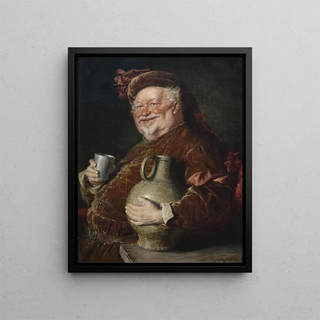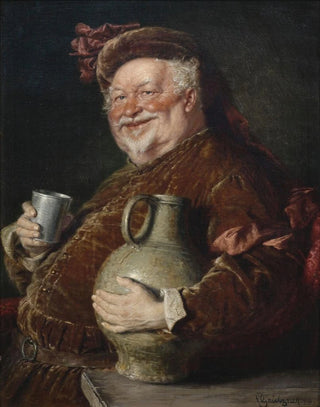Art print Falstaff at the table with a jug of wine and a pewter cup - Eduard von Grützner | Art print


View from behind

Frame (optional)
In the rich and complex universe of art, some works manage to capture moments of life with such intensity that they transcend the simple frame of painting. The art print of Falstaff at the table with a wine jug and an pewter cup by Eduard von Grützner is one of these masterpieces. It invites the viewer to immerse themselves in a vibrant scene where the famous character of Falstaff, from Shakespearean imagination, finds himself at the heart of a feast. The composition, full of life and meticulous details, evokes not only the conviviality of a banquet but also a reflection on human nature, joy, and excess. This depiction, both festive and introspective, captures the eye and the mind, offering an immersive experience that goes beyond mere observation.
Style and uniqueness of the work
Eduard von Grützner's style is distinguished by his ability to combine realism with a certain form of romanticism. In this piece, warm colors and the interplay of shadow and light create a welcoming and intimate atmosphere. The precision of details, whether in the textures of clothing or the shine of objects in pewter and glass, demonstrates exceptional craftsmanship. Falstaff's jovial posture, his mischievous smile, and his sparkling gaze capture the very essence of this iconic character. Grützner manages to infuse a dynamic quality into the scene, where each element seems to interact with the others, reinforcing the idea of a celebration of life. The work does not merely depict a frozen moment; it tells a story, that of a man enjoying the pleasures of life while subtly revealing underlying melancholy.
The artist and his influence
Eduard von Grützner, born in 1846, was a German painter whose work is rooted in the realism movement. Influenced by his contemporaries, he developed a distinctive style, oscillating between faithful representation of reality and a certain idealization of subjects. Grützner dedicated a significant part of his career to exploring themes related to conviviality, gastronomy, and the

Matte finish

View from behind

Frame (optional)
In the rich and complex universe of art, some works manage to capture moments of life with such intensity that they transcend the simple frame of painting. The art print of Falstaff at the table with a wine jug and an pewter cup by Eduard von Grützner is one of these masterpieces. It invites the viewer to immerse themselves in a vibrant scene where the famous character of Falstaff, from Shakespearean imagination, finds himself at the heart of a feast. The composition, full of life and meticulous details, evokes not only the conviviality of a banquet but also a reflection on human nature, joy, and excess. This depiction, both festive and introspective, captures the eye and the mind, offering an immersive experience that goes beyond mere observation.
Style and uniqueness of the work
Eduard von Grützner's style is distinguished by his ability to combine realism with a certain form of romanticism. In this piece, warm colors and the interplay of shadow and light create a welcoming and intimate atmosphere. The precision of details, whether in the textures of clothing or the shine of objects in pewter and glass, demonstrates exceptional craftsmanship. Falstaff's jovial posture, his mischievous smile, and his sparkling gaze capture the very essence of this iconic character. Grützner manages to infuse a dynamic quality into the scene, where each element seems to interact with the others, reinforcing the idea of a celebration of life. The work does not merely depict a frozen moment; it tells a story, that of a man enjoying the pleasures of life while subtly revealing underlying melancholy.
The artist and his influence
Eduard von Grützner, born in 1846, was a German painter whose work is rooted in the realism movement. Influenced by his contemporaries, he developed a distinctive style, oscillating between faithful representation of reality and a certain idealization of subjects. Grützner dedicated a significant part of his career to exploring themes related to conviviality, gastronomy, and the
12,34 €






